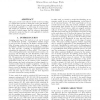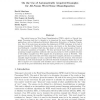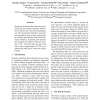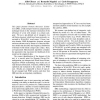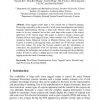250 search results - page 11 / 50 » Learning Probabilistic Models of Word Sense Disambiguation |
NAACL
1994
15 years 1 months ago
1994
This paper presents and evaluates models created according to a schema that provides a description of the joint distribution of the values of sense tags and contextual features th...
100
click to vote
JAIR
2008
14 years 12 months ago
2008
This article focuses on Word Sense Disambiguation (WSD), which is a Natural Language Processing task that is thought to be important for many Language Technology applications, suc...
EMNLP
2007
15 years 1 months ago
2007
We present results that show that incorporating lexical and structural semantic information is effective for word sense disambiguation. We evaluated the method by using precise in...
EMNLP
2004
15 years 1 months ago
2004
This paper presents Domain Relevance Estimation (DRE), a fully unsupervised text categorization technique based on the statistical estimation of the relevance of a text with respe...
132
click to vote
LKR
2008
15 years 1 months ago
2008
Sense tagged corpus plays a very crucial role to Natural Language Processing, especially on the research of word sense disambiguation and natural language understanding. Having a l...
